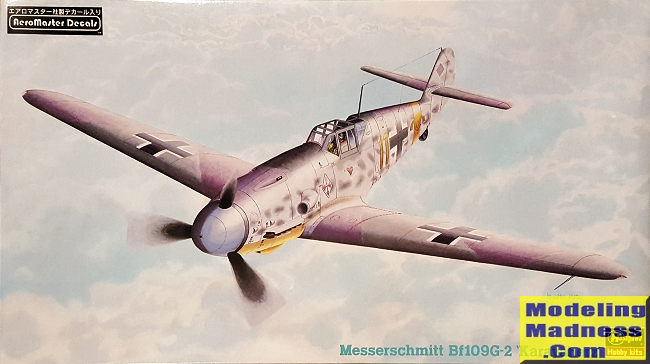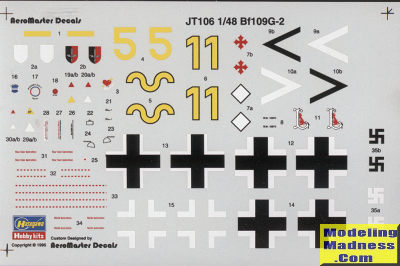
Hasegawa 1/48 Bf-109G-2 'Karayahertz'
| KIT #: | 09166 (Jt 106) |
| PRICE: | 2200 yen when new |
| DECALS: | Three options |
| REVIEWER: | Scott Van Aken |
| NOTES: | 1995 release |

| HISTORY |
The G series of the Bf-109 saw the introduction of the DB.605 engine,
which, in various guises, was to remain the powerplant of the 109 until the end
of production. The G-2, which started production in May 1942, lacked the cabin
pressurization and GM-1 installation of the G-1. Performance-wise it was
identical to the G-1. The canopy reverted to one layer of glazing and
incorporated the angled head armour used on the F-4, although several G-2 had
the vertical type as fitted to the G-1. Several Rüstsätze could be fitted,
although installing these did not change the designation of the aircraft.
Instead the "/R" suffix referred to the G-2's Rüstzustand or equipment condition
of the airframe, which was assigned at the factory rather than in the field.
Over 1,500 G-2s were built between May 1942 an February 1943.
| THE KIT |
 Hasegawa
started releasing its Bf-109E kits in 1988. In 1991, the F model hit the
shelves, followed by the early G kits. All of the Hasegawa's 'round wing' 109s
have a basic set of sprues to which whatever additional sprues are added in
order to produce the variant being kitted. This often means that small details
will have to be either filled in or removed and holes will need to be opened.
All these kits come with a standard F wing and this requires the wheel well
openings to be cut to the G shape.
Hasegawa
started releasing its Bf-109E kits in 1988. In 1991, the F model hit the
shelves, followed by the early G kits. All of the Hasegawa's 'round wing' 109s
have a basic set of sprues to which whatever additional sprues are added in
order to produce the variant being kitted. This often means that small details
will have to be either filled in or removed and holes will need to be opened.
All these kits come with a standard F wing and this requires the wheel well
openings to be cut to the G shape.
The cockpit tub is nicely detailed with separate sidewalls. No instrument decals with this one, but nice raised detailing. The cockpit can be inserted from the underside once the fuselage halves are put together. The wings have separate flaps and radiator exhaust doors. In addition, the slats are separate items.
The prop has separate blades that are keyed to the spinner backing plate. Probably the most fiddly part of the build is the upper cowling which is two pieces. With Hasegawa 109G kits, the exhaust can be installed from the outside and after painting. Landing gear are well done with separate oleo scissors. There is a drop tank for under the fuselage. You are provided a three piece cockpit enclosure so the canopy can be posed open. Unlike the E kits, there is no photoetch, which many modelers prefer.
 Instructions
are standard fare for Hasegawa with Gunze paint references. This boxing uses
Aeromaster decals and provides three options. The first two are in standard RLM
74/75/76 with fuselage mottling. These are from the Eastern front with yellow
fuselage band and lower wing tips. One is the box art plane of Herman Graf in
September 1942. Next is the plane of Walter Krupinski about the same time frame.
The third is a desert scheme plane in RLM 79/78 with RLM 80 mottling. This one
has a white fuselage band and yellow lower cowling. Note that there is a
template for Graf's aircraft to paint the center of the fuselage cross with RLM
74.
Instructions
are standard fare for Hasegawa with Gunze paint references. This boxing uses
Aeromaster decals and provides three options. The first two are in standard RLM
74/75/76 with fuselage mottling. These are from the Eastern front with yellow
fuselage band and lower wing tips. One is the box art plane of Herman Graf in
September 1942. Next is the plane of Walter Krupinski about the same time frame.
The third is a desert scheme plane in RLM 79/78 with RLM 80 mottling. This one
has a white fuselage band and yellow lower cowling. Note that there is a
template for Graf's aircraft to paint the center of the fuselage cross with RLM
74.
| CONCLUSIONS |
Though surpassed by the Eduard kit in terms of detailing, the Hasegawa kit is not as fussy a build as the Czech option and still well worth picking up and building.
| REFERENCES |
https://en.wikipedia.org/wiki/Messerschmitt_Bf_109_variants#G-1,_G-2
June 2022
Copyright ModelingMadness.com. All rights reserved. No reproduction in part or in whole without express permission from the editor.
If you would like your product reviewed fairly and fairly quickly, please contact the editor or see other details in the Note to Contributors.